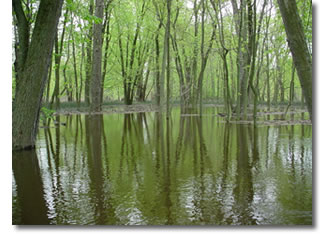Muskegon River Primary Productivity

This project is an add-on to the Muskegon River Initiative, an existing Great Lakes Fisheries Trust (GLFT) project. One of the major components is the "Mega Model" project. The data collected by AWRI will serve as additional input into the Mega Model.
The Mega Model project combines the considerable wealth of data, experience, and tools that already exist in Michigan through the ongoing efforts at the University of Michigan, Michigan State University, Grand Valley University, their partners in state government (MDEQ, MDNR), and watershed stakeholders. This collaborative effort is unique and draws upon the diverse talents of many different organizations. Building upon existing models, data, and management tools, a system-wide model will be produced and used to perform risk assessment in the Muskegon River Watershed. See the Muskegon Watershed Research Partnership (MWRP) website for links to other related projects.
AWRI has overlapping efforts dedicated to this project, including wetland ecology investigations by Dr. Uzarski and nutrient/contaminant investigations by Dr. Rediske. Dr. Steinman and his research assistant Mary Ogdahl are working in conjunction with Dr. Stevenson and his research assistants at MSU. Together, they will measure algal and plant biomass, productivity, and species composition in habitats throughout the lower Muskegon Estuary system over the next 3 years.
The role of seasonal, spatial, and flow-dependent variations in river and estuarine habitat availability in sustaining fish production in Lake Michigan, Muskegon Lake, and the Muskegon River is poorly understood. Estimating costs and benefits of management options to local fisheries requires the ability to model resulting changes in essential habitat that may affect sport fishes and their prey.
The lower Muskegon Estuary System contains many diverse physical habitats that support valuable and diverse fisheries. However, elements of essential habitat are already clearly stressed as indicated by the limited reproduction of important fishery species (walleye, Chinook salmon, steelhead). Also, the critical habitat needs of several other ecological important fishes (lake sturgeon, suckers) are poorly understood. Availability of spawning substrates, temperature, macrophytes which can provide refuge from predators and flow, large wood debris, acceptable hydraulics, and appropriate food sources are all potentially critical components of fish habitat.
We are specifically focusing on the autotrophic components of fish food sources. Working closely with researchers from MSU, plant surveys will be conducted to assess biomass, productivity, and species composition in all aquatic macrohabitat units.
Algal and periphyton biomass in streams, lakes, and wetlands will be determined by sampling and with rapid survey techniques to increase the spatial and temporal frequency of sampling. Rapid periphyton survey techniques are estimates of macroalgal cover and microalgal thickness on substrata.
Metabolism will be studied through the use of benthic chambers and Biochemical Oxygen Demand (BOD) bottles.
This project was funded by the Great Lakes Fisheries Trust
Publication:
Ogdahl, M., V.L. Lougheed, R.J. Stevenson, and A.D. Steinman. 2010. Influences of multi-scale habitat on metabolism in a coastal Great Lakes watershed. Ecosystems 11: 222-238.
Project Partner:
Dr. Jan Stevenson, Michigan State University, [email protected]
Project Contacts:
Dr. Alan Steinman, Project Manager, [email protected]
Mary Ogdahl, Lead Technician, [email protected]

